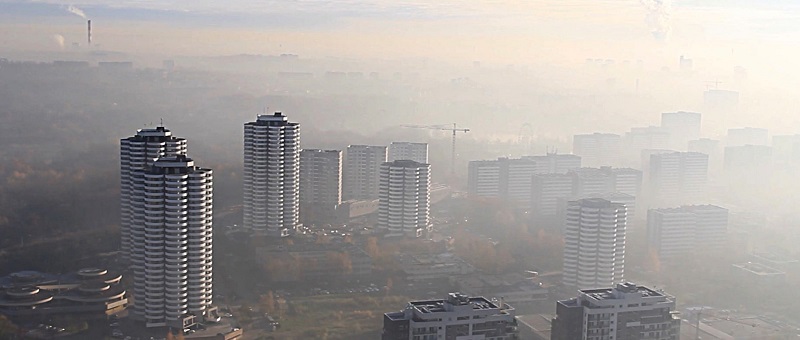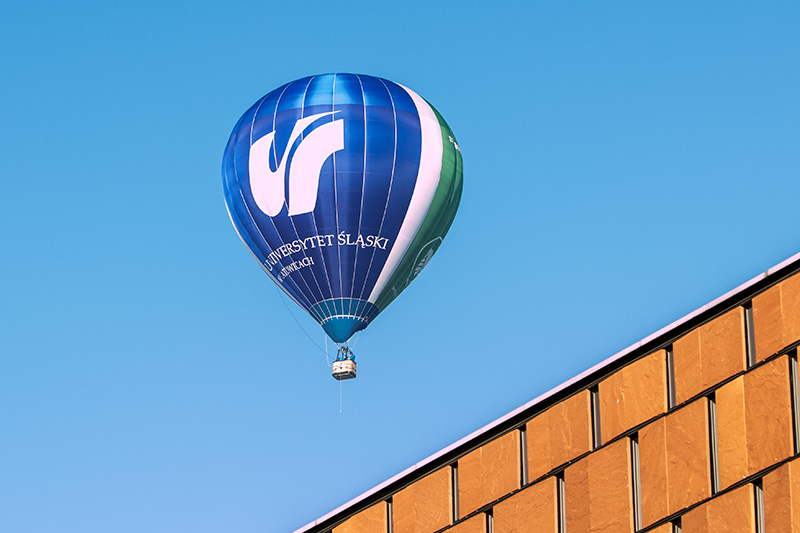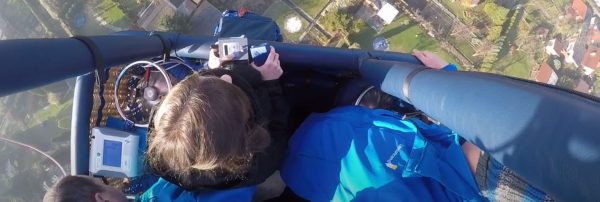As many as 36 of the 50 most polluted cities in the European Union are located in Poland. Worldwide, researchers from various scientific disciplines join the fight against smog to counteract its aftermaths, including health threats resulting from air pollution. Scientists from the University of Silesia monitor air quality using the first and only overhead laboratory in Poland placed in a hot air balloon basket, which is a part of the University Laboratories for Atmosphere Control (ULKA). The balloon is hovering over the cities of the Metropolis GZM and collects data that allows researchers to map the occurrence of pollution.
The work of the team is led by Mariola Jabłońska, PhD, DSc, Assoc. Prof.
|Maria Sztuka|
In 1952, the Great Smog of London caused approx. 4,000 deaths within a week, and in the subsequent weeks, 8,000 more people died. The accumulation of several factors led to this ecological catastrophe. An increased use of lower quality coal for heating flats caused thick fog and lower temperatures. Subsequently, temperature inversion blocked the vertical mixing of air in the atmosphere. It took the wind 5 days to disperse the deadly cloud of gases and dust emitted by heating stoves, power plants, factories, and vehicle exhaust fumes. 67 years have passed since these dramatic events, and smog has remained a crucial threat to humanity. According to data provided by the European Environment Agency, 46,000 people die due to smog per year. Of the 50 most polluted cities in the European Union, 36 are located in Poland. Scientists from all over the world join the comprehensive fight against smog-related threats.

From the beginning, scientists from the University of Silesia employed at the Institute of Earth Sciences at the Faculty of Natural Sciences have researched environmental pollution. It is therefore not surprising that, since 2016, they use the first and nationwide only aerial laboratory in the basket of a manned hot-air balloon. The balloon takes the University Laboratories for Atmosphere Control (ULAC) to a height of 4 kilometers. It flies in circles above the cities of the Silesia agglomeration and collects comprehensive data regarding the quality of the air which its inhabitants breathe. This project features participants from numerous disciplines: meteorologists, climatologists, mineralogists, biologists, physicists, chemists, hydrologists. The work of the team is coordinated by Assoc. Prof. Mariola Jabłońska, a geochemist, mineralogist, and environmental protection specialist.
The balloon permits not only to analyze air quality, but also helps to identify sources of pollution and to detect in which directions they spread. Due to the fact that the balloon does not have an engine, its horizontal movement corresponds to the natural movement of the air, and this creates the unique opportunity to collect samples in areas of the atmosphere which have not been interfered with by mechanical devices.

Although drones have already been employed to assess the quality of air, their capabilities are very limited, especially in comparison to the balloon, which is able to lift a weight of 1,200 kg. The crew (4 people and a pilot), gas cylinders, and the basket constitute the most substantial load, and specialist equipment makes up the remainder. Therefore, using this balloon with a capacity of 3400 m3 , a fullfledged laboratory is able to embark on a trip. One of its most important elements is a nanoparticle analyzer (from 10 to 300 nanometers) equipped with an additional device which enables the scientists to collect nanoparticle samples to be analyzed by means of transmission electron microscopy. Subsequently, their contents and sizes are studied in laboratories on the ground. Another device is a dust analyzer which is able to determine the concentration of microparticles in a range from 0.3 to 10 micrometers and provides information regarding the percentage of e.g. respirable dusts which penetrate the respiratory system. What is the importance of this research for the inhabitants of the surrounding areas?
– Both nanoparticles and microparticles of less then 0.5 micrometers, that is, 500 nanometers, behave like gases. This means that they directly reach the bloodstream and constitute an enormous threat, since they enter our bodies as we breathe, the scientist explains.
The balloon also carries aspirators used to draw in air onto special dust filters which are subsequently analyzed under electron scanning microscopes in order to determine their type and size. Biologists use their own equipment, that is, devices used to collect plant pollen and fungus spores as well as a device which collects microbiological samples. The containers are filled with fluids which permit to securely collect bacteria so that they are not killed in transport. Later, they are forwarded to a laboratory where scientists grow them and study them under the microscope. A team of geochemists specializing in organic matter identify harmful compounds and determine their origin. Chemists place a high-flow aspirator (2.5 m3 per minute) in the balloon. Its filters permit to determine the chemical composition of the collected dust. Another newly acquired analyzer is used to study the concentration of gases: nitric oxide and dioxide, sulfur dioxide, ammonia, ozone, and benzene. In the nearest future, an analyzer permitting to determine the concentration of volatile organic compounds and carbon dioxide, the last missing gas measurement device, will be included as well.

A weather station is another indispensable element of the balloon’s equipment, since it collects information regarding temperature, humidity, and atmospheric pressure. Devices which register the direction and speed of the wind belong to the aircraft’s standard equipment. In order to avoid contamination from the burner, all devices are placed under the balloon basket. The data collected during the flight, which lasts from 1 to 3 hours, permit to gather extensive information. The analyses are performed in cycles every 4 seconds, and, according to the project’s coordinator, this guarantees a very precise detection time. Due to the fact that the GPS remembers the route and height of the flight, geographers compile a precise map which shows where pollution occurs, determine its sources, and identify situations which favor its accumulation. This knowledge will be passed on to medical doctors, city administrators, and the municipalities. The fight against smog demands a full mobilization of all scientists. In the balloon, there is still much space left, and the flying laboratory is open to innovative ideas.
Source: „A Flying Laboratory Checks Air Quality”„No Limits” no. 1(1)/2020.





